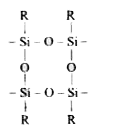On controlled hydrolysis and condensation, R3SiCl yields
A
R3Si−O−SiR3
B
(R3Si−O−SiR3)n
C
R3SiOH
D

Video Solution
Text Solution
The correct Answer is:A
R3SiCl on hydrolysis forms only a dimer.
R3SiOH+HOSiR3→R3Si−O−SiR3.
|
Topper's Solved these Questions
- The p-Block Elements (Group 13 and Group 14)Book:DISHA PUBLICATIONChapter:The p-Block Elements (Group 13 and Group 14)Exercise:Exercise-2: Concept Applicator
Explore 30 Videos
- The p-Block Elements (Group 13 and Group 14)Book:DISHA PUBLICATIONChapter:The p-Block Elements (Group 13 and Group 14)Exercise:Exercise-1: Concept Builder (Topicwise)
Explore 32 Videos
- THE D- AND F- BLOCK ELEMENTS Book:DISHA PUBLICATIONChapter:THE D- AND F- BLOCK ELEMENTS Exercise:EXERCISE - 2 CONCEPT APPLICATOR
Explore 30 Videos
- THE P-BLOCK ELEMENTS (GROUP 15, 16, 17 & 18)Book:DISHA PUBLICATIONChapter:THE P-BLOCK ELEMENTS (GROUP 15, 16, 17 & 18)Exercise:Exercise
Explore 110 Videos
Similar Questions
Alkyl substituted chlorosilane, RnSiCl(4−n), on hydrolysis and then condensation polymerisation yield silicones What is the value of n is the alkyl substituted chlorosilane used for the preparation of cross linked silicone.
View SolutionThe hydroglysis of trialkychlorosilane , R3SiCl, yields ……………………..,
View Solution
Knowledge Check
Ethers on hydrolysis yield
AketoneBacidCalcoholDaldehydeThe role of addition of Me3SiCl during the hydrolysis followed by conduction of Me3SiCl2 is.
ATo catalyte the reaction.BTo terminate the chain and hence controlling the molecular weight.CFor obtaiming a proper cross linking.DAll of the aboveUrea upon hydrolysis yields
AAcetamideBCarbonic acidCAmmonium hydroxideDNO2
Urea upon hydrolysis yields
View SolutionStatement-I: (CH3)3 SiCl produces polymeric silicons on hydrolysis and followed by condensation
Statement-II: Silicon does not form Si=0 due to less effective lateral overlapping of 3p-2p orbitals
View SolutionHydrolysis of fat yields
View SolutionAl4C3 on hydrolysis yields
View SolutionBe2C on hydrolysis yields
View Solution